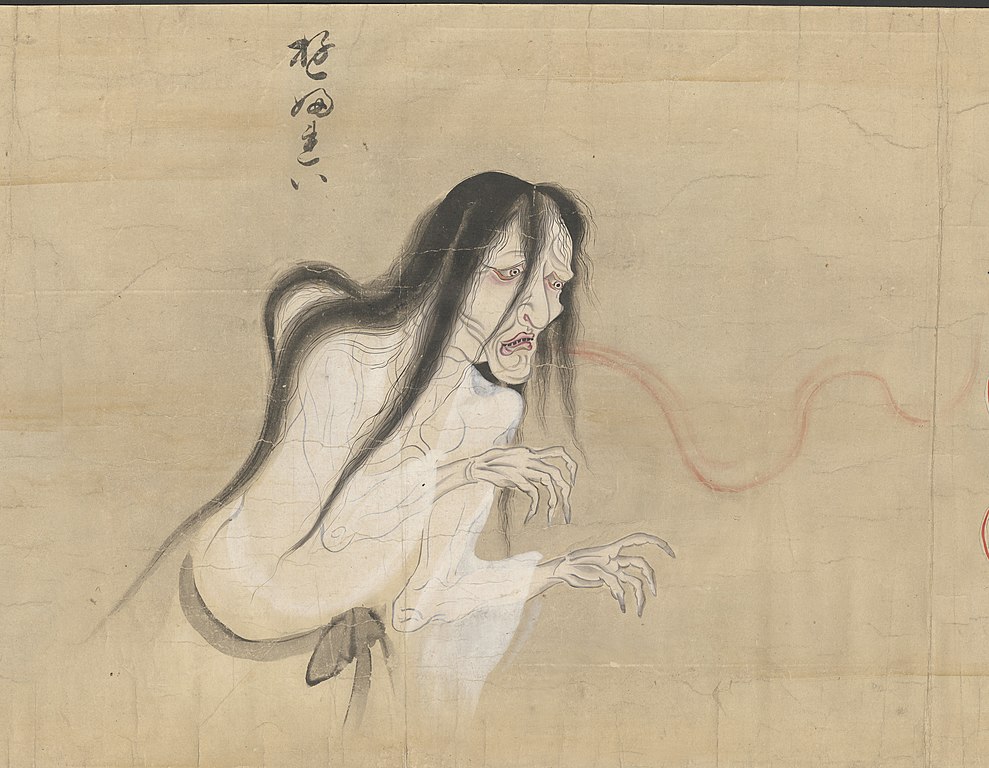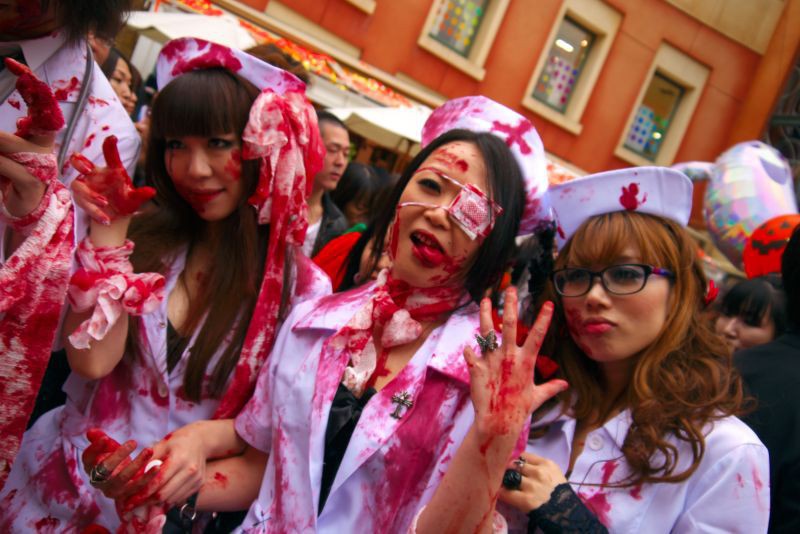Tripatini
the world's smartest travel social network
The Supernatural - and Halloween - in Japan
by Jorge Tejada
The Land of the Rising Sun is home to an ancient culture with a sometimes tumultuous history, and through these many centuries, inevitably some of that history has been haunted with all manner of ghosts, demons, monsters, and ghouls. And in the 21st century, that haunted heritage has if anything become more popular than ever thanks to its promotion and adaptation in pop culture, including manga comic books; anime and horror movies; and video games. So to mark Halloween today, here's a quick look at the supernatural in Japan - and as the Japanese say, Happii Harowin!
 Brigham Young University
Brigham Young University
Folklore and Mythology
The main elements of the supernatural in traditional Japanese lore revolve around yūrei (ghosts), often depicted as garbed in white, with long, black, disheveled hair, and floating legless in the air. There are also a number of subtypes, depending on their purpose, or whether they're malign or benign. For example, onryō come back from purgatory to avenge a wrong done to them during their lifetime, while zashiki-warashi are the ghosts of children, more mischievous than dangerous, and fuyūrei are floating spirits who don't have any particular purpose and wander aimlessly. Then there are the gaki and the jikininki, "hungry ghosts" who in Buddhist tradition are for their sins condemned to hunger to feed on corpses and other repugnant things and substances.
The panoply of other monsters and demons inhabiting Japanese folklore include the hyosube, a hairy, foul-smelling river goblin; the vicious, weasel-like kamaitachi; the jorogumo (half beautiful woman, half huge spider); the katakirauwa, a kind of demonic pig; the tsuchigumo (body of a tiger, limbs of a spider, and face of a demon); and the yamauba (a cannibalistic mountain ogress). All told, quite enough for a lifetime of nightmares!
Traditional and Pop Culture
Yūrei have been depicted for centuries not just in art but also on stage in classical bunraku (puppet) and Noh theatre (the latter even has a substantial subgenre of kiri no, demon plays). But of course the post-World-War-II burgeoning of pop culture opened the door toward amplifying and adding to all the scary stuff accreting in the culture over thousands of years (in addition, of course to the famous kaiju movie tradition of modern monsters such as Godzilla, Gamera, and Mothra). And today horror and the supernatural have become one of Japan's more popular genres.
In cinema, one of the major Japanese scare flicks of all time is Ringu (Ring) - based on a 1991 novel, released in 1998, and remade by Hollywood just four years later - updating the classic yūrei theme and dealing with a reporter who investigating a cursed videotape that kills the viewer seven days after watching it. It inspired a revival of the horror genre with subsequent live-action movies such as Dark Water, The Grudge, Pulse, and Uzumaki (aka Vortex), based on a horror manga. Anime also offers up loads of the spooky, from traditional to futuristic, such as Elfen Lied, Mononoke (particularly notable for being done in ancient Japanese style), Parasyte, Tokyo Ghoul, and Zombie-Loan - not a few of these also based on manga.
Speaking of which, these graphic novels with roots reaching as far back as the 12th century have in recent years taken the occult as one of their favourite themes, with prominent examples including the aforementioned Uzumaki (the story of a fictional city which is plagued by a supernatural curse involving spirals) as well as Blood Lad, Deadman Wonderland, Death Note, Soul Eater, and Vampire Knight.
Video games have also gotten into the act in a major way, both adapting traditional Japanese paranormal themes and adding sometimes wildly inventive new ones. One of them, Fatal Frame, deals with ghosts, exorcism, and sinister Shinto rituals, based on a real-life case of ritual sacrifice and brutal family slayings at Himuro Mansion, somewhere in a forest near Tokyo. Others include Calling: Kuroki Chakushin, Corpse Party, Night of Sacrifice, and Siren: Blood Curse.
 Era
Era
Famous Haunted Sites
One of the two most famous such spots is Himeji Castle, in the eponymous city in the Kansai region of Japan's main island, Honshu, three hours by train west of Tokyo. Considered the finest surviving example of the classic Japanese castles of yore, it's also said to be haunted by Okiku, the vengeful jibakurei ghost of a murdered servant girl.
But the single most famous is Aokigahara Forest (above), sitting on a field of hardened lava on the northwest flank of Mount Fuji an hour 40 minutes west of Tokyo, consisting of 30 square kilometres (12 sq. miles) of conifers, broadleaf trees, flowering plants, and a wide variety of birds and other fauna. Near the village of Narusawa, the so-called "Sea of Trees" has a historical reputation for being haunted by the yūrei of elderly or sick people who in ancient times were abandoned here (a practice known as ubasute, not unlike how some old-time Inuit of the Arctic used to leave their elderly out on icebergs). Whether you believe that or not, its mystique has led to some very real - and tragic - spookiness in the present day, as hundreds of depressed people are drawn to these dense, bosky environs to attempt suicide, all too often successfully. You'll even see signs imploring people to think of their families and contact suicide prevention lines. Beyond the creepy feeling this gives many visitors, a few have even come across actual bodies - and that of course is the most horrifying of all.
 Danny Choo
Danny Choo
Halloween in Japan
This U.S. holiday has increasingly become something of "a thing" here since Tokyo Disneyland and Universal Studios Japan in Osaka started doing Halloween events and themes 19 years ago, and it's more geared toward adults than kids, turning Japanese youth's love of kosupure (cosplay) toward scary themes. There's no trick or treating, but Halloween parties, festivals, and parades, along with customs like carving jack o' lanterns, have become popular with some, particularly in the larger cities; a number of businesses also get into the act with appropriate décor and products. A more organically local analogue falls in August, when during the three-day Obon festival in mid August, when tradition has it the spirits of the ancestors visit the living, with paper lanterns and public folk dances marking the occasion, along with telling stories of ghosts and the supernatural.
So once again, with feeling - Happii Harowin!
Videos
Groups
-
India
173 members
-
Tour Operators
873 members
-
Ireland
93 members
-
South Dakota
17 members
-
Azerbaijan
17 members
-
Shopping the World
55 members
-
Tech for Travel/Hospital…
87 members
-
Andorra
26 members
-
Online Corner
75 members
-
Minnesota
22 members
-
Backpackers & Hostels
84 members
-
Portugal
60 members
-
Turks and Caicos
26 members
-
Agritourism/Farmstays
72 members
-
Zambia
21 members
© 2025 Created by EnLinea Media.
Powered by
![]()
Badges | Report an Issue | Privacy Policy | Terms of Service

You need to be a member of Tripatini to add comments!
Join Tripatini